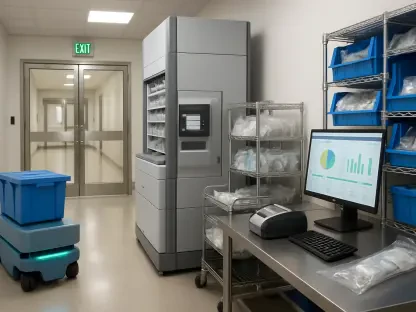The landscape of healthcare is undergoing a profound shift as financial and regulatory pressures mount, positioning the medical billing solutions market for remarkable evolution over the next decade from 2025 to 2035. This critical sector, pivotal to the financial health of hospitals and clinics worldwide, is being reshaped by rapid digitization and the urgent need for streamlined revenue cycles. As healthcare providers grapple with increasingly complex reimbursement models and stringent compliance mandates like HIPAA in the U.S., the demand for cutting-edge billing and coding technologies has surged. This sets a dynamic stage for innovation, where stakeholders—from technology vendors to medical facilities—are racing to adapt to a future defined by efficiency and accuracy. The scope of this market spans diverse products, including software and hardware, and extends across varied applications in hospitals and clinics, while reaching every corner of the globe, from North America to Asia-Pacific. Understanding these trends offers a window into the transformative decade ahead.
Market Drivers and Growth Opportunities
Technological Advancements and Digitization
The transition from traditional paper-based systems to sophisticated electronic billing platforms stands as a cornerstone of growth in the medical billing solutions market. This shift, gaining momentum across global healthcare settings, is driven by the need to manage vast amounts of patient and financial data with precision and security. Advanced software solutions are at the heart of this change, enabling healthcare providers to process claims faster, reduce errors, and maintain detailed records. Beyond operational benefits, digitization addresses the pressing requirement for compliance with strict regulations, such as HIPAA, which mandates robust safeguards for patient information. As healthcare systems continue to modernize, the reliance on integrated electronic solutions is expected to deepen, creating fertile ground for vendors to innovate and expand their offerings. This technological wave not only enhances efficiency but also positions providers to meet evolving patient and payer expectations over the coming years.
Another dimension of this digital push is the growing investment in infrastructure to support these systems, particularly in regions with advanced healthcare frameworks like North America and Europe. The emphasis on secure data handling has led to the development of solutions that prioritize encryption and real-time monitoring to prevent breaches. Meanwhile, the scalability of digital platforms allows even smaller clinics to adopt tailored systems without prohibitive costs, broadening market access. Regulatory pressures continue to act as a catalyst, compelling organizations to upgrade outdated processes to avoid penalties and ensure seamless audits. This convergence of technology and compliance is reshaping how revenue cycles are managed, with an eye toward reducing administrative burdens. As the decade unfolds, the pace of digitization will likely accelerate, driven by both necessity and the promise of improved financial outcomes for healthcare entities navigating tight budgets and complex payer landscapes.
Impact of AI and Machine Learning
Artificial intelligence (AI) and machine learning (ML) are poised to revolutionize the medical billing solutions market by automating repetitive tasks and enhancing accuracy in critical processes. These technologies can analyze vast datasets to predict claim denials before they occur, allowing providers to address issues proactively and minimize revenue loss. By streamlining coding processes, AI-driven tools reduce human error, ensuring that claims align with payer requirements and regulatory standards. This capability is especially vital as the healthcare industry shifts toward value-based care models, where precise billing directly impacts reimbursement rates. The integration of such advanced tools into existing software platforms signals a transformative leap, promising not only operational efficiency but also significant cost savings for healthcare facilities facing financial strain in an era of rising expenses.
Beyond automation, the predictive power of AI and ML offers deeper insights into revenue cycle management, enabling providers to optimize their financial strategies over time. These technologies can identify patterns in billing errors or delays, providing actionable data to refine processes and improve cash flow. Additionally, their ability to adapt to changing regulations and payer policies ensures that billing systems remain compliant without constant manual updates. This adaptability is crucial in a landscape where policies evolve rapidly, often outpacing traditional software capabilities. As adoption grows from 2025 to 2035, the focus will likely shift toward making these solutions accessible to smaller providers through cloud-based models, democratizing access to cutting-edge tools. The synergy of AI with broader industry trends underscores a future where data-driven decision-making becomes the norm, fundamentally altering how healthcare organizations approach their financial operations.
Competitive Landscape and Key Players
Leading Innovators and Market Share
In the highly competitive arena of medical billing solutions, several key players are shaping the market through innovation and strategic positioning. Companies such as OSP Labs, Infinx Healthcare, and Optum Coding Intelligence have emerged as leaders, each carving out significant market share with distinct approaches to product development and customer engagement. Their focus on creating user-friendly software that integrates seamlessly with electronic health record (EHR) systems has set a high standard for functionality and reliability. Additionally, these firms leverage advanced marketing strategies to highlight their unique value propositions, whether through competitive pricing or specialized features tailored to large hospitals. Their influence extends beyond product offerings, as they drive industry standards and push for technological advancements that benefit the broader market during this decade of growth.
The competitive edge of these market leaders also stems from their ability to forge strategic partnerships and expand their global footprint, particularly in high-growth regions. Investments in research and development allow them to stay ahead of emerging trends, such as the integration of AI into billing platforms, ensuring relevance in a fast-evolving sector. Furthermore, their emphasis on customer support and training helps healthcare providers maximize the benefits of complex systems, fostering long-term loyalty. The diversity in their approaches—ranging from niche solutions for specific medical fields to comprehensive packages for large systems—illustrates the dynamic nature of competition. As the market progresses from 2025 onward, the ability of these companies to anticipate regulatory shifts and technological needs will likely determine their sustained dominance, while also inspiring smaller players to innovate and challenge the status quo in this crowded field.
Strategic Positioning and Industry Influence
Beyond individual market share, the broader strategies employed by leading firms reveal a deeper layer of competition focused on long-term sustainability and influence. Many top players are prioritizing mergers and acquisitions to consolidate expertise and expand their technological capabilities, creating comprehensive solutions that address multiple facets of revenue cycle management. This approach not only strengthens their market position but also allows them to offer bundled services that appeal to healthcare providers seeking integrated systems. Additionally, a strong emphasis on data analytics as part of their offerings helps clients gain insights into financial performance, further solidifying their role as indispensable partners. The ripple effect of these strategies shapes industry benchmarks, pushing competitors to elevate their standards and adapt to a landscape increasingly defined by consolidation and innovation.
Another critical aspect of strategic positioning lies in addressing the unique needs of diverse healthcare settings, from sprawling hospital networks to independent clinics with limited budgets. Leading companies are investing in customizable solutions that cater to varying scales of operation, ensuring broader market penetration. Their proactive engagement with regulatory bodies also positions them as thought leaders, influencing policy discussions that impact billing practices globally. This dual focus on adaptability and advocacy enhances their credibility while opening doors to new markets, especially in regions undergoing healthcare reform. As the period from 2025 to 2035 unfolds, the ability to balance innovation with accessibility will be paramount, with industry giants likely to set the tone for how medical billing evolves. Their influence will continue to drive a market where technological prowess and strategic foresight are key to maintaining a competitive advantage.
Market Segmentation and Regional Insights
Product and Application Trends
The medical billing solutions market is distinctly segmented by product type and application, with software emerging as the dominant force due to its scalability and integration capabilities with electronic health record systems. Unlike hardware, which plays a more foundational role in supporting infrastructure, software solutions offer flexibility to adapt to changing needs, making them indispensable for modern healthcare providers. Hospitals, with their high patient volumes and intricate billing requirements, remain the primary users, driving significant demand for robust systems that can handle complex claims and reimbursement processes. This dominance reflects the critical need for efficiency in large-scale medical environments where financial stakes are high, and even minor errors can lead to substantial revenue losses over time.
Meanwhile, the rise of clinics as a key application segment underscores a growing trend toward accessible, cost-effective billing solutions tailored to smaller operations. These facilities often operate with tighter budgets, prompting vendors to develop streamlined platforms that deliver essential functionality without overwhelming costs. The focus on user-friendly interfaces and cloud-based options caters to this demographic, enabling clinics to modernize without extensive infrastructure investments. Additionally, the shift toward outpatient care models globally further amplifies this segment’s importance, as more patients seek services outside traditional hospital settings. As the market evolves through 2025 and beyond, the balance between sophisticated solutions for hospitals and affordable tools for clinics will shape product development, ensuring that diverse healthcare needs are met across the spectrum of care delivery.
Geographic Variations in Growth
North America continues to lead the medical billing solutions market, bolstered by its advanced healthcare infrastructure and widespread adoption of cutting-edge technologies. Stringent regulatory frameworks, such as HIPAA, compel providers in this region to invest heavily in compliant systems, sustaining high demand for innovative billing tools. The presence of major technology vendors and a well-established payer ecosystem further solidifies this dominance, making North America a benchmark for market standards. However, challenges such as rising implementation costs and the need for constant system updates persist, requiring ongoing adaptation to maintain this leadership position over the next decade.
In contrast, the Asia-Pacific region is rapidly emerging as a high-growth hub, fueled by increasing healthcare expenditures and supportive government initiatives in countries like China and India. Population growth and the push to modernize medical systems are driving investments in digital billing solutions, though infrastructural limitations pose hurdles to swift adoption. Meanwhile, regions like South America and the Middle East & Africa exhibit slower but steady progress, constrained by economic challenges yet buoyed by foreign investments and gradual policy reforms. These disparities highlight the need for region-specific strategies, with vendors tailoring solutions to local conditions. From 2025 to 2035, the global market will likely see a convergence of growth patterns as emerging areas catch up, reshaping the competitive dynamics and opening new avenues for expansion.
Challenges and Future Outlook
Barriers to Adoption
Despite the promising growth of the medical billing solutions market, significant barriers to adoption remain, particularly in developing regions where resources are limited. Data security stands as a paramount concern, with healthcare providers wary of breaches that could compromise sensitive patient information and lead to legal repercussions. The complexity of integrating new systems with existing infrastructure often exacerbates these fears, as outdated technology may not support advanced security protocols. Additionally, the high upfront costs of implementing sophisticated billing platforms deter smaller facilities from upgrading, perpetuating reliance on manual processes that are prone to errors. These challenges are especially pronounced in areas with fragmented healthcare systems, where standardization remains elusive.
Another critical obstacle lies in the shortage of trained personnel capable of managing and maintaining advanced billing technologies. Without adequate expertise, even the most cutting-edge systems can underperform, leading to inefficiencies that undermine their value. Regulatory variations across regions further complicate adoption, as providers must navigate a maze of compliance requirements that differ widely between countries. This creates a patchwork of implementation challenges, slowing market penetration in less developed areas. Addressing these barriers will require concerted efforts from technology providers and policymakers to offer affordable, user-friendly solutions and robust training programs. As the decade progresses, overcoming these hurdles will be essential to ensuring equitable access to the benefits of modern billing systems.
Emerging Opportunities
Amidst the challenges, the medical billing solutions market is ripe with opportunities, particularly through the rise of cloud-based platforms that offer scalability and affordability. These solutions eliminate the need for extensive on-site hardware, reducing costs for healthcare providers of all sizes and enabling real-time access to billing data from any location. This flexibility is especially valuable for clinics and smaller hospitals that lack the resources for traditional systems, allowing them to compete in a digital landscape. Furthermore, cloud technology facilitates seamless updates and integration with other healthcare tools, ensuring that providers remain agile in the face of changing regulations and payer policies. This trend is set to gain traction from 2025 onward, reshaping how financial operations are conducted.
Another promising avenue lies in the increasing demand for outsourcing billing services to specialized vendors, a practice that alleviates administrative burdens for healthcare providers. By delegating complex revenue cycle tasks to experts, facilities can focus on patient care while benefiting from enhanced claim accuracy and faster processing times. This model also offers cost predictability, as providers pay for services rather than investing in expensive infrastructure. As global healthcare costs continue to rise, outsourcing is likely to become a strategic choice for many, particularly in regions where in-house expertise is scarce. Looking ahead to 2035, these emerging opportunities signal a market poised for innovation, where accessibility and efficiency will drive the next wave of growth and transformation.









